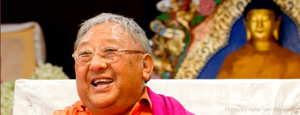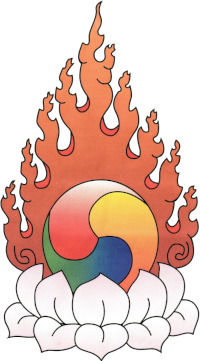At the same time, today is a very important Buddhist festival day. It is the day that the Prayer Festival, known as Mönlam festival, is held. Many of you are familiar with the word Mönlam. It is one of the important Tibetan spiritual celebration days. Even after we came to India in 1959, for a number of years, we have been doing it continuously. We missed one year, but then the prayer festival was continued in India by the Tibetans. Nowadays it has become so popular. It is called Chö trul Mönlam festival. Chö trul is the magical month, the first month in the lunar calendar in Tibetan Buddhism.
Why is it called magical month? Because this is the month in which Buddha had a magical competition with his challengers. There were 6 other masters, great Hindu masters, anti-Buddhist masters, actually. I don’t know their names in Sanskrit or English, but in Tibetan two of them are known as Wösung, and Dzog che. Wösung means probably Kashyapa in Sanskrit. So there were six of them. That happened when Buddha was at the age of 57. He had become very popular and famous in India, in all these little Indian kingdoms. I still have a problem with the names in Sanskrit. The names of those Indian kings were introduced to me in Tibetan. They translated the names into Tibetan. So we call them like Gyalpo Sakye, Gyalpo Magheda, Gyalpo this, and Gyalpo that. So in Sanskrit I don’t know, but one of them is definitely called Bimbisara.
During that time there were all these little kingdoms in India and almost all the royal families became disciples of Buddha. According to what I know, according to what Buddhist literature tells you in Tibetan, those six other teachers were very challenged by Buddha’s popularity and had a little difficulty to receive good treatment from the families in public, particularly from the royal families. So they were a little bit inconvenienced. So they thought, “We will have a magical competition between Buddha and us. If Buddha plays one magic, we will play two of them. So we will defeat him, so that people will think we are okay and good.”
That’s how they were planning. Some Tibetan documents will also tell you that some of them were dealing with the devil. Whatever it is, this is a 2600 year-old story, and generation after generation, in different languages, all kinds of things will come in. So, those guys went to the rulers there and put the challenge, asking for a magical competition, so that everybody would know who was good at it. It was not the question who was better spiritually, which is something that you can’t see and figure out. So that’s what those six challengers did.
Finally, they sent messengers to Buddha and he agreed. Then they were supposed to build a special place for the magical competition, somewhere between Varanasi and Kushinagar in Bihar. We went there on our last India pilgrimage. Unfortunately I only know the name in Tibetan: nye yö. That’s where Buddha had the summer retreat and somewhere there they built a place. So Buddha agreed that after seven days there would be the magical competition.
Buddha went around in different kingdoms at that time, here and there and all these six would follow Buddha everywhere. They were thinking that Buddha was running away from the competition and they said, “Now is the time where we have to prove that he can’t challenge us.” They started following him around the different kingdoms. Finally, when they reached to that place, Buddha said, “In seven days.” According to the historical books that I have read, those guys came very early in the morning, saying, “Today, the seventh day is over. Now we are here. The king must order Gautama – that’s what they called Buddha – to have the magical competition.” So the king sent a messenger to invite Buddha and the name of the messenger was Chiu Lama, that means “Small monk,” or something. So the way Buddha came was by flying in the air, like an eagle.
He came in that way. Then he was meditating on the fire element out of the five elements, air, fire, water, earth and space. When he came in flying, because of the power of the fire element, the place of the competition caught fire. There was a big fire. So these six said, “Great, if Gautama is great, let him protect this place from the destruction of fire.” The moment they said that, Buddha stopped his meditation on fire and all the fire died down. And not only that, that fire had burnt the dust and dirt and everything and made the environment very beautiful.
In that manner, they had competitions, one after another. Neither is there enough time, nor do I remember all of them, but every day there were different magical shows. On the second day, the feast was offered by one of the other kings and according to what I read, something happened with a toothpick. The toothpicks then were different from those we have today. At the time of the Buddha, he was ordering his disciples to use toothbrushes. But they were not real brushes, but little wood twigs. They would chew the end of the twig, and through that it would become a little hairy, and that hairy part of the twig was then used to clean the tartar on the teeth. That was the toothbrush then. This was 2600 years ago, and there were no brushes and no electronic brushes. There was nothing of that sort.
When that king offered the feast, Buddha picked up one those toothpicks, and put it in the ground and it became a huge tree, with beautiful flowers and fruit together, simultaneously. Normally, that doesn’t happen, right? Normally, flowers come first and then buds and then fruit. But Buddha manifested all of them simultaneously. That type of magical competition went on for 8 days. On the 8th day all those six ran away. Then it became Buddha’s magical performance for a few more days. Altogether that went from the first to the 15th day of the month. It was the year when Buddha was 57 years old. So this is why this month is called the magical month.
~ Gelek Rimpoche, Jewel Heart Ann Arbor, March 16, 2014



